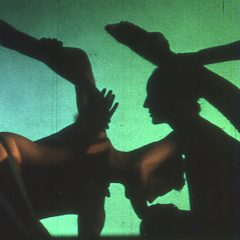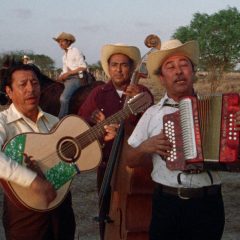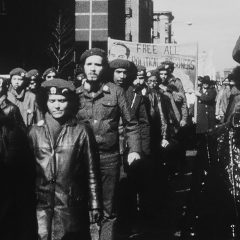Coinciding with its one year anniversary, the Lightbox Film Center devoted the month of April to hosting a retrospective of Nouveau Vague director Philippe Garrel’s astonishing and underappreciated body of work. With an oeuvre spanning more than fifty years, it must surely have been difficult to select just a few highlights, but Lightbox assembled a truly resplendent and well-considered selection of rarely-seen gems.
Garrel began making films as a teenager coming of age amidst the tumult of Paris in the 1960s. His earliest endeavors follow disaffected young protagonists who will be familiar to audiences acquainted with iconic films of the period such as François Truffaut’s 400 Blows or Jean-Luc Godard’s Breathless. In Garrel’s first film, the fifteen-minute-long Les enfants dés accordés (The Out-of-Tune Children), a boy and a girl run away from home and play indifferently at adulthood. They loiter around the city, looking tragically bored. Wearing matching nightshirts, she pushes him through a grassy field in a wheelchair as he puffs on a cigar. They arrange their bodies in disturbing, abstract tableaux in and around a stately country manor house. They read newspaper reports of the Aberfan coal mine collapse, a disaster that claimed the lives of 116 children in South Wales as a result of corporate negligence. Garrel occasionally cuts to shots of their parents and other authority figures opening on the question of what is wrong with this new generation. The student uprisings of May ’68 indelibly marked Garrel. His early films thrum with a burgeoning political consciousness that would later take the form of a radically anti-narrative aesthetic. This new mode suggested a break with the limiting causality of the cinema of the past, and pointed towards the possibility of historical rupture and revolution.
Psychic voyages
In his silent 1968 Le révélateur (The Revealer), a hauntingly dead-eyed man and a woman with their effervescent child in tow make a pilgrimage through various uncanny landscapes, some built, some natural, all forbiddingly empty. They appear to be seeking refuge from some nameless danger. The child is at once a burden and a source of purpose, even sustenance. In one particularly arresting long tracking shot, the camera follows the boy through a dark tunnel until he meets his mother kneeling in wait for him at the end. He throws himself on her breast and the lights blaze bright. The woman’s face is so washed out as to become featureless, spectral. Her son’s embrace seems capable of both reviving her and sucking her dry. Similarly ambivalent, hermetic images stand in for the plot points of this plotless film. This could be the first family or the last, victims or perpetrators of unspeakable trauma. Little in the way of factual detail is revealed by The Revealer. Instead, the film’s visual vocabulary offers a rich panoply of disquieting associative prompts, ensuring that each spectator’s psychic journey will be unique.

In the ‘70s, Garrel’s films could resemble veritable hallucinations. La cicatrice intérieure (The Inner Scar) is an unbounded quest allegory starring Pierre Clementi and Nico, the unearthly German beauty with whom Garrel lived for ten years after her tenure as a Warhol superstar. Shot on location in North Africa, Iceland, and Death Valley, The Inner Scar consists of Nico and Clementi traversing barren wastes so severe and devoid of any trace of civilization that they might as well be on a distant planet. Sometimes Nico rides a horse. Clementi is frequently nude. Periodically, the wanderers pass a patch of fire burning unattended in the sand. Nico issues occasional gnomic pronouncements in English or German. She weeps and rages, now attempting to separate from Clementi, now finding it impossible to do without him. With her willowy body and dirge-like voice, Nico is threnody incarnate. During one scene shot in front of a waterfall surrounded by lush greenery, the film’s sole reprieve from an otherwise unrelentingly arid setting, Nico intones plaintively, “We can never be here until we’ve gone.” Her Edenic backdrop bespeaks a paradise lost and unrecoverable by the living save for in fleeting visions such as those the cinema can provide.
A Biographical Approach
After Garrel parted ways with Nico (and their shared heroin habit) and underwent electroshock therapy to treat his severe depression, he unsurprisingly became a very different filmmaker. From the ‘80s on, his films employ more conventional dialogue, characterization, and recognizably “realistic” human situations, often including details drawn from Garrel’s own biography. His J’entends plus la guitar (I Can No Longer Hear the Guitar) was made in response to Nico’s death, and features the German actress Johanna ter Steege as the protagonist’s captivating, but self-destructive beloved. She evokes Nico without attempting to portray her. In this deceptively emotional film, love proves stubbornly unrepresentable; what we are left with is the gasping fear, nostalgia, and grief that fills the space in between brief moments of happiness. In Les baisers des secours (Emergency Kisses) Garrel himself stars opposite his real-life wife Brigitte Sy. They play a film director and his wife whose marriage is threatened when Garrel’s character refuses to cast Sy’s character in a role based on her. These more domesticated, mature films are tender and funny in the vein of Woody Allen’s best work, resting comfortably within the boundaries of the medium rather than trying to push beyond its limits. Lightbox has given Philadelphia a great gift in inviting us to trace the full trajectory of this singular artist’s career.
For nearly forty years, the film program at the International House has shown an eclectic mix of new, independent, and foreign films, alongside sumptuous retrospectives and revivals. Since rebranding as the Lightbox Film Center in 2017, the program has quickly established itself as Philadelphia’s answer to New York’s Film Forum or Metrograph (where a somewhat more comprehensive retrospective of Garrel’s work showed last year). Lightbox is a treasure. Run, don’t walk to whatever is playing next.
To stay up-to-date on all of their programs, visit the Lightbox Film Center Calendar.









